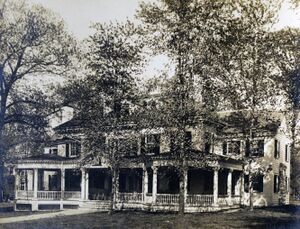New Jersey: Difference between revisions
(Created page with "{{short description|New Jersey State Building}} {{Infobox prepared food | name = New Jersey State Building | image = New Jersey State Building.jpg | image_size = 300px | caption = New Jersey State Building | alternate_name = | country = | creator = | course = | cost = $15,000 ({{Inflation|US|15,000|1904|fmt=eq}}) | admission = | profit = | owner = | main_ing...") |
No edit summary |
||
| Line 21: | Line 21: | ||
New Jersey's state building was a practical reproduction of the old Ford Tavern at Morristown, N.J., which was used as Washington's headquarters during the winter of 1779-80. Alexander Hamilton made his home there that winter, and at the inn, met the daughter of General Schuyler, whom he afterwards married. Among other famous men who have been beneath its roof were Lafayette, Steuben, Kosciusko, "Light Horse" Harry Lee, "Mad Anthony" Wayne, and Benedict Arnold. The 63 x 84 foot building was located on the [[Plateau of States]]. | New Jersey's state building was a practical reproduction of the old Ford Tavern at Morristown, N.J., which was used as Washington's headquarters during the winter of 1779-80. Alexander Hamilton made his home there that winter, and at the inn, met the daughter of General Schuyler, whom he afterwards married. Among other famous men who have been beneath its roof were Lafayette, Steuben, Kosciusko, "Light Horse" Harry Lee, "Mad Anthony" Wayne, and Benedict Arnold. The 63 x 84 foot building was located on the [[Plateau of States]]. | ||
==Etymology== | |||
==Before the Fair== | |||
==Description== | |||
Inside, wall papers of colonial pattern and antique furniture in vogue during the revolutionary days were displayed. A feature of the main hall was the old-fashioned fire-place and interesting collection of relics of historic value. On the main floor, a room was reproduced to look like the one Washington used as a as a bed-chamber. | Inside, wall papers of colonial pattern and antique furniture in vogue during the revolutionary days were displayed. A feature of the main hall was the old-fashioned fire-place and interesting collection of relics of historic value. On the main floor, a room was reproduced to look like the one Washington used as a as a bed-chamber. | ||
| Line 30: | Line 35: | ||
In the Palace of Liberal Arts interesting exhibits were displayed by various business enterprises of the state. | In the Palace of Liberal Arts interesting exhibits were displayed by various business enterprises of the state. | ||
==After the Fair== | ==After the Fair== | ||
Revision as of 18:05, 9 November 2022
 New Jersey State Building | |
| Construction Cost | $15,000 (equivalent to $452,389 in 2021) |
|---|---|
New Jersey's state building was a practical reproduction of the old Ford Tavern at Morristown, N.J., which was used as Washington's headquarters during the winter of 1779-80. Alexander Hamilton made his home there that winter, and at the inn, met the daughter of General Schuyler, whom he afterwards married. Among other famous men who have been beneath its roof were Lafayette, Steuben, Kosciusko, "Light Horse" Harry Lee, "Mad Anthony" Wayne, and Benedict Arnold. The 63 x 84 foot building was located on the Plateau of States.
Etymology
Before the Fair
Description
Inside, wall papers of colonial pattern and antique furniture in vogue during the revolutionary days were displayed. A feature of the main hall was the old-fashioned fire-place and interesting collection of relics of historic value. On the main floor, a room was reproduced to look like the one Washington used as a as a bed-chamber.
New Jersey had nice displays in the Palaces of Mines and Metallurgy and Forestry, Fish and Game; but their largest exhibit was at the Palace of Education.
Because of the cost of shipping fresh New Jersey produce to the Fair on a steady basis, the state did not display in the Palace of Agriculture.
In the Palace of Electricity New Jersey displays ranked among the best, as was also the case in the Palace of Machinery.
In the Palace of Liberal Arts interesting exhibits were displayed by various business enterprises of the state.
After the Fair
After the Fair closed, the building was relocated Kirkwood, Missouri and was turned into a four-apartment complex. It was later torn down.
